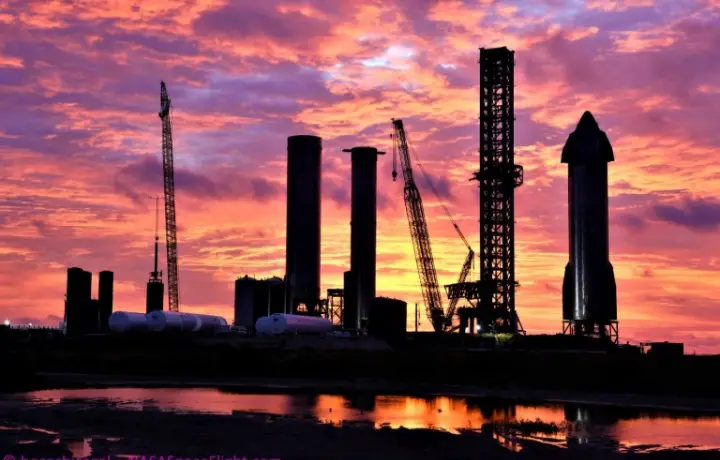With the approach of the first orbital flight of Starship, Orbital Launch Pad project in Starbase, Texas, is being constructed to launch readiness. Over a year of development there comes various complex’s elements to the verge of ushering the most powerful rocket in history.
Tank Farm
The tank farm contains a water tank and seven others for different commodities. Three of the tanks contain LOX (Liquid Oxygen), CH4 (Liquid Methane) on two while the remaining two contains LN2 (Liquid Nitrogen).
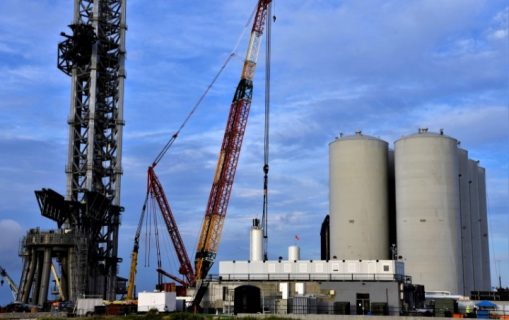
Additionally, there are two horizontal CH4 tanks on the main tank farm side but their exact size is not known. The water tank is just a huge cylinder made up of stainless steel rings. The other seven are double-walled cladded with insulation between them due to their state of holding liquids at cryogenic temperatures. The inner tanks are constructed almost the same way SpaceX constructs the 9-meter diameter ship and booster tanks with rolls of 304L Stainless steel. The tanks are required to withstand constant pressurization and depressurization every time, hence the extra reinforcement.
The outer shells, having 12 meters wide, are constructed with stainless steel rings and painted white to protect from thermal heating and corrosion. To help insulation on inner tanks and maintain the cryogenic liquids below the boiling point, the space between the shell and tank is filled with the Perlite insulation. Perlite insulation is an inorganic material with a great thermal properties which doesn’t support combustion.
Launch Mount
The launch mount is the place full Starship stack will stand before the launch. It must be able to hold against at least 74.4 MN of thrust.
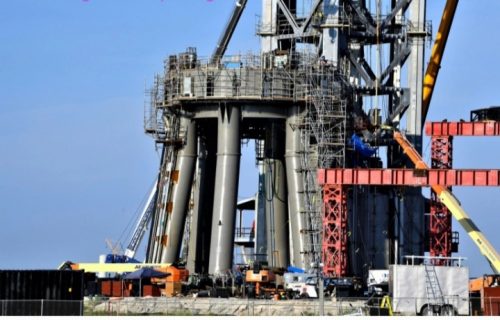
The mount includes critical components like the hold-down clamps, booster quick disconnect and the water deluge system for the sound suppression. The launch table contains 20 different hold-down clamps attaching to the bottom of the booster for orbital pad’s static fires and launches. For launches, the hold-down clamps will release the moment all the engines on the booster will be at nominal thrust.
Integration Tower (Mechazilla)
The integration tower will have a distinctive piece of hardware.
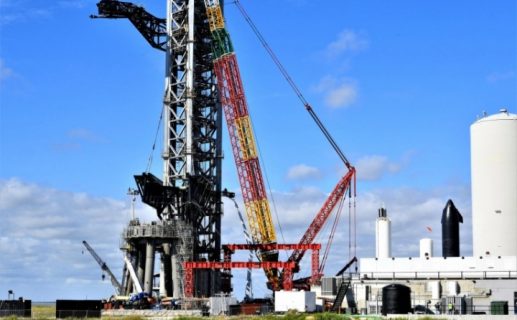
Mechazilla, name given by Elon Musk, must be 145 meters tall and should have the job of stacking the booster and Starship together with catching them when they come back for landings. Mechazilla wiill perform this with assistance of two arms which can lift and catch the booster from hardpoints which are between the grid fins. The Starship will be lifted and caught from hardpoints right on the forward flaps.
Read also: The WestConnex project in Sydney Australia.
Timeline
June 22, 2020
SpaceX commenced constructing the orbital launch pad with teams attempt to install the concrete rebar for 6 pillars of the orbital launch mount. After constructing reinforcement steel rebar, a steel cylinder was fixed over the rebar and every pillar was filled with concrete and covered to cure. After the pillars were done, there was no great progress on the Orbital Launch Pad (OLP) since the focus was shifted back to flying the SN8 and SN9 vehicles. While the testing efforts on SN9, 10, and 11 were ongoing, SpaceX commenced working on the OLP again by starting to lay the tank farm’s foundations and the associated Ground Support Equipment (GSE) bunkers. They also started the installation of piping for the tank farm.
April 5, 2021
A critical milestone was reached when GSE tank 1 got rolled out and 3 days later lifted onto its mount in the tank farm. Later, during SN15’s test campaign, the building work at the OLP escalated, because SpaceX was on a point in the program where they had to test the whole stack and not just the ship. During the surge, GSE 2 was deployed on April 19 and lifted onto its position in the tank farm. On the same day, together with the GSE tanks installation, the foundation for the Integration tower was constructed and the tower’s first steel pillar was added to the foundation. Also the dirt berm between the tank farm and landing pad was being developed before SN15 made the historic flight. When SN15 recovered and retreated to the build site, SpaceX progressed to rapidly constructing the OLP. The Quick Disconnect arm and catching arms construction started on the landing pad. Another huge development milestone was achieved when the ntegration tower roof section was installed on July 28.
August 2021
Three days after the launch table installation, SpaceX rolled Booster 4 (B4) and later 2 days S20 for fit checking with the booster interstage and launch table.
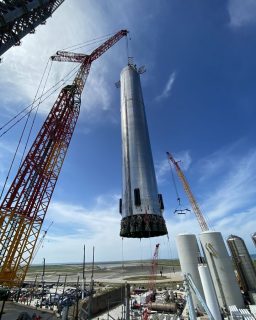
After the fit checks were done, B4 was then removed and rolled back to the build site to complete. SpaceX went on working on the Orbital Launch Pad project by beginning to add piping and conduit for the integration tower, the orbital pad and another between the tank farm and the orbital pad. While fixing all of the needed piping, the quick booster disconnect was installed on the launch table still on 26th August, and the Quick Disconnect arm was installed on the Integration tower on 29th. On 22nd September, SpaceX cryo tested Ground Support Equipment 5 on the tank farm.
October 2021
In October 6, FC lifted the Carriage onto the tooling that was built in so as to assemble the whole system on the ground before installing in the tower. On 9th October, the first arm was lifted into place by FC, then Bucky lifted the second arm two days later. LOX was first seen loaded into the tank farm on October 17. The final Cryo shell was sleeved over GSE 2 on October 19, hence completing all the GSE tanks and shells. The Catching system was lastly installed on the integration tower on 20th October.
December 2021
Work remained to complete the Orbital Launch Pad project to a level best for launch operations, but the main constituents are in place to help a maiden orbital flight of Starship by next year or so, waiting vehicle readiness and regulatory approvals. On 3rd December, company has revealed building a pad for Starship at Launch Complex 39A, part of NASA’s Kennedy Space Center in Cape Canaveral, SpaceX founder and CEO Elon Musk said.
Late December 2021
The first orbital test launch of the mammoth rocket ship ever from Earth is set in for January 2022. The Starship test launch will become a pathway back to the moon for the first time after a half a century and also might be the first spacecraft to eventually land human being on Mars. It will also be the first spacecraft with all components being fully reusable. This significantly reduces the traditionally astronomic space travel costs. The spacecraft has unprecedented in-flight refueling capacity, allowing for much frequent and efficient operations.
Starship will be driven into orbit by a first-stage booster rocket named Super Heavy, on which SpaceX fixed 29 of its Raptor engines before releasing the entire craft to the launchpad at the Starbase launchpad in December 2021. With around 16m pounds of thrust, and a magnitude to carry up to 165 tons from surface of the Earth’s, Starship power is almost twice as that of the Saturn V rockets that propelled 12 astronauts to the moon between 1969 and 1972. No exact date has been set in January for the Starship’s orbital test launch. This will follow a series of much successful suborbital travels from Texas over the last two years. If successful, Musk stated that up to a dozen further flights would follow in 2022, with Starship’s first lunar voyage, which is a 2023 space tourism venture funded by Yusaku Maezawa, a Japanese billionaire.
